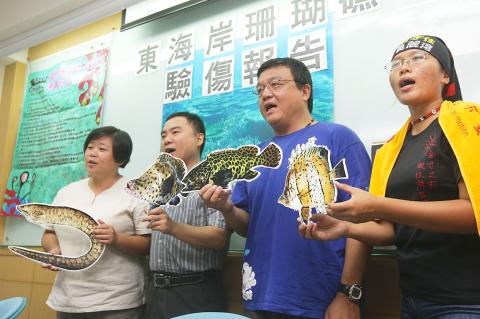The coral reefs off the nation’s eastern coast, especially near Taitung County’s Shanyuan Bay (杉原灣) and Jihuei Fishing Port (基翬漁港), are rapidly being destroyed by construction development along the shore, environmental organizations said yesterday.
The groups made the statement as they publicized an annual report documenting findings on the health of the nation’s major coral reef habitats.
This year’s report was the third annual investigation of the nation’s coral reefs. Among the seven areas targeted this year were the northeast coast, Shanyuan Bay and Jihuei Fishing Port, Green Island (綠島), Orchid Island (蘭嶼), Dongyuping (東嶼坪) in Penghu County and Siaoliouciou (小琉球).

Photo: CNA
“There is about 30 percent coral cover [the proportion of reef surface covered by live stony coral] off the coast of Taitung, but now the corals reefs are dying as a result of construction dirt washed into the sea,” said Chen Chao-lun (陳昭倫), director of the Penghu Symbiotic Algae Association and a research fellow with the Biodiversity Research Center at Academia Sinica.
Coral cover at Shanyuan Bay and Jihuei Fish Port had reached a “high” and “medium” percentage rate of decline according to the Reef Check Worldwide organization’s standards, Chen said, adding that more than a hundred species of coral had been recorded in the waters of Shanyuan Bay, including the rare species of Oulophyllia bennettae.
After 25 years of diving and observing coral habitats, Chen said he had seen first hand that many beautiful coral reefs are actually very fragile and being seriously damaged by onshore construction, with observations showing about 7 percent of coral was killed this year, compared with only about 1 percent to 2 percent last year.
Association secretary-general Chen Jui-pin (陳瑞賓) said the survey demonstrated that the marine environment was being severely impacted by onshore developments, suggesting that future environmental impact assessments conducted on major construction projects in coastal areas should include an assessment of impacts on the local marine environment.
He also urged the government to establish marine reserves to preserve the local marine environment.
Further talks with fishermen would also be necessary to explain to them the potential benefits of sustainable fishing, which could be achieved by setting up marine reserves, Chen Jui-pin added.
Taitung County Chenggung Hometown Caring Association chief secretary Sung Ming-yan (宋明燕) said there are currently a number of development projects near Jihuei Fishing Port, including an amusement park.
The developers are destroying the local environment without the consent of local residents, Sung said.
Dayuang Huang (黃苑蓉), a representative of the Erythrina Tribe (刺桐部落), an Aboriginal community living near the construction site of the beachfront Meiliwan Resort Hotel (美麗灣渡假村) at Shanyuan Bay, said that although the courts had ordered the project be stopped, the developers had ignored the ruling and had been given permission by the county government to continue building the resort.
Local residents have witnessed unrecognizable waste and dirt being buried under the sand at Shanyuan Bay on numerous occasions, Huang said.
He expressed concern that the project would not only damage the natural beauty of the beach, but also destroy the ecosystem of traditional fishing grounds.

The disruption of 941 flights in and out of Taiwan due to China’s large-scale military exercises was no accident, but rather the result of a “quasi-blockade” used to simulate creating the air and sea routes needed for an amphibious landing, a military expert said. The disruptions occurred on Tuesday and lasted about 10 hours as China conducted live-fire drills in the Taiwan Strait. The Civil Aviation Administration (CAA) said the exercises affected 857 international flights and 84 domestic flights, affecting more than 100,000 travelers. Su Tzu-yun (蘇紫雲), a research fellow at the government-sponsored Institute for National Defense and Security Research, said the air

Taiwan is to commence mass production of the Tien Kung (天弓, “Sky Bow”) III, IV and V missiles by the second quarter of this year if the legislature approves the government’s NT$1.25 trillion (US$39.78 billion) special defense budget, an official said yesterday. Commenting on condition of anonymity, a defense official with knowledge of the matter said that the advanced systems are expected to provide crucial capabilities against ballistic and cruise missiles for the proposed “T-Dome,” an advanced, multi-layered air defense network. The Tien Kung III is an air defense missile with a maximum interception altitude of 35km. The Tien Kung IV and V

Trips for more than 100,000 international and domestic air travelers could be disrupted as China launches a military exercise around Taiwan today, Taiwan’s Civil Aviation Administration (CAA) said yesterday. The exercise could affect nearly 900 flights scheduled to enter the Taipei Flight Information Region (FIR) during the exercise window, it added. A notice issued by the Chinese Civil Aviation Administration showed there would be seven temporary zones around the Taiwan Strait which would be used for live-fire exercises, lasting from 8am to 6pm today. All aircraft are prohibited from entering during exercise, it says. Taipei FIR has 14 international air routes and

Taiwan lacks effective and cost-efficient armaments to intercept rockets, making the planned “T-Dome” interception system necessary, two experts said on Tuesday. The concerns were raised after China’s military fired two waves of rockets during live-fire drills around Taiwan on Tuesday, part of two-day exercises code-named “Justice Mission 2025.” The first wave involved 17 rockets launched at 9am from Pingtan in China’s Fujian Province, according to Lieutenant General Hsieh Jih-sheng (謝日升) of the Office of the Deputy Chief of the General Staff for Intelligence at the Ministry of National Defense. Those rockets landed 70 nautical miles (129.6km) northeast of Keelung without flying over Taiwan,